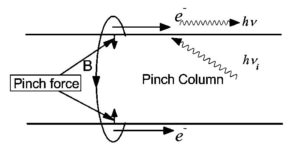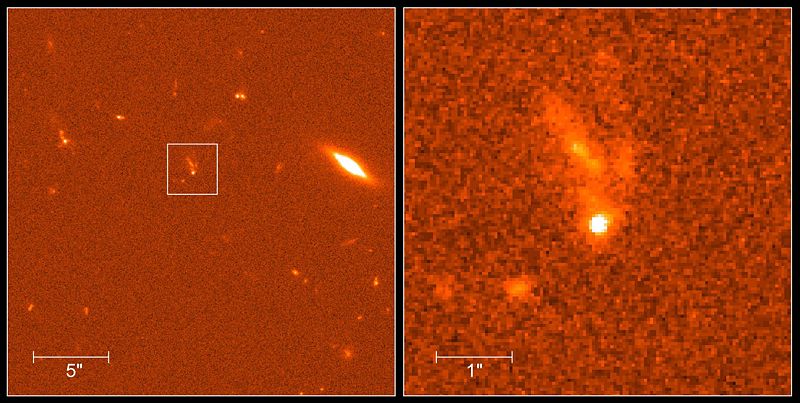Gamma-ray bursts (GRBs) are the most luminous electromagnetic events occurring in the universe. They are flashes of gamma rays emanating from seemingly random places in deep space at random times. The duration of a gamma-ray burst is typically a few seconds, but can range from a few milliseconds to several minutes, and the initial burst is usually followed by a longer-lived “afterglow” emitting at longer wavelengths (X-ray, ultraviolet, optical, infrared, and radio). Gamma-ray bursts are detected by orbiting satellites about two to three times per week, but the number of GRBs that could be observed from Earth is about three times this and is currently limited by the efficiency of the instruments.
The means by which gamma-ray bursts convert energy into radiation remains poorly understood, and as of 2007 there is still no generally accepted model for how this process occurs.[1] A successful model of GRBs must explain not only the energy source, but also the physical process for generating an emission of gamma rays which matches the durations, light spectra, and other characteristics observed.[2]
Plasma universe model of GMB
The plasma universe model of GMBs (Gamma ray bursts) is that of a large-voltage, high-temperature plasma pinch discharge mechanism, based on the observation of Alfven that many of the explosive events observed in cosmic physics are produced by disruptive discharges of electric double layers in current cables.[3] A disruptive discharge will cause the plasma cable to pinch into a very narrow column by inward magnetic pressure of the discharge current (Krall & Trivelpiece 1973[4]). The resulting compressed, large-voltage and high-temperature discharge column will radiate flaring energetic photons due to ICS (Inverse Compton Scattering) between the accelerated electrons and thermal photons.[5]

A very similar phenomenon to gamma ray bursters that adds further credence for the electrical pinch discharge model of GRB’s are Intense gamma-ray flashes, which have been observed by BATSE/CGRO and shown to be of atmospheric origin, and are often called TDFs. TDFs are similar to GRBs in emission energy band and morphology. An evident correlation of the gamma rays produced by TGFs with thunderstorm system (Fishman et al. 1994)[6] and their features of energy dependence of time profiles (Feng et al. 2002)[7] indicate that TGFs are produced by upward explosive electrical discharges at high altitude, giving observational evidence that the discharge process can produce high-energy explosive events. Before the burst the energy is supposed to be stored in an electric circuit with current I and inductance L as inductive energy W = LI2/2.
It has been realized that there is an atmospheric electrical global circuit, in which a current flows between the ionosphere and the earth with thunderstorms as a d.c. generator[8][9]. Another kind of high-energy transients similar to GRBs is the solar hard X-ray flare. Alfven & Carlqvist suggested exploding discharges of electric double layers to be responsible for solar flares. In their model, the energy release and particle acceleration of a flare are produced by the disruption discharge of a current of 1011 − 1012 A, flowing in a solar atmosphere circuit with a typical length 109 − 1010 cm and inductance ~ 10 H. The pinch discharge scenario could account for the energy budget even for GRBs at cosmological distances, as the pinch discharge mechanism can naturally interpret many observed GRB characteristics[10]. Complicated morphological patterns in GRBs, such as the wide variety of profile configurations, richly fluctuating or structurally smooth, rapid rise vs slower fall, weak precursor and secondary pulse, etc., are common in various electrical discharges.[5]
Footnotes
- ↑ Boris E. Stern and Juri Poutanen Gamma-ray bursts from synchrotron self-Compton emission (2004) arXiv:astro-ph/0405488v2, Associated with Astronomy Division, University of Oulu, Finland
- ↑ Fishman, Gerald J.Gamma-Ray Bursts: an Overview (1995) Publications of the Astronomical Society of the Pacific, v.107, p.1145 PEER REVIEWEDFULL TEXT
- ↑ Hannes Alfvén, “Section II.6. Electric Double Layers” and “II.7. Field-Aligned Currents as `Cables'” in Cosmic Plasma, Astrophysics and Space Science Library, Vol. 82 (1981) Springer Verlag. ISBN 90-277-1151-8 ACADEMIC BOOK
- ↑ Krall N. E., Trivelpiece A. W. Principles of Plasma Physics (1973) McGraw-Hill, Inc. ACADEMIC BOOK . Also published in Plasma Science, IEEE Transactions on 1974[1]
- ↑ 5.0 5.1 Mei Wu, Li Chen and Ti-Pei Li Polarization in Gamma-Ray Bursts Produced by Pinch Discharge Chin. J. Astron. Astrophys. Vol. 5 (2005), No. 1, 57–64 PEER REVIEWEDFULL TEXT
- ↑ Fishman G. J. et al Discovery of Intense Gamma-Ray Flashes of Atmospheric Origin 1994, Science, 264, Vol. 264. no. 5163, pp. 1313 – 1316 PEER REVIEWED
- ↑ Feng H., Li T. P., et al Temporal and spectral properties of gamma-ray flashes 2002, Geophysical Research Letters, Volume 29, Issue 3, pp. 6-1 PEER REVIEWEDFULL TEXT
- ↑ Ralph Markson and Michael Muir Solar Wind Control of the Earth’s Electric Field 1980, Science Vol. 208. no. 4447, pp. 979 – 990 PEER REVIEWED
- ↑ Ralph Markson Modulation of the Earth’s electric field by cosmic radiation 1981, Nature 291, 304 – 308 PEER REVIEWED
- ↑ Li, Ti-Pei Heliospheric Origin of Gamma-Ray Bursts 1997, Chin. Phys. Let., 14, 557 PEER REVIEWED
